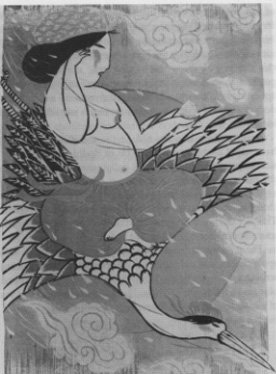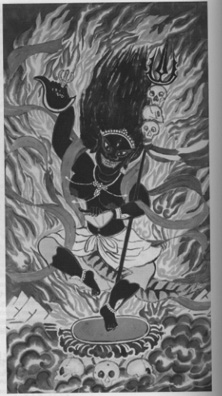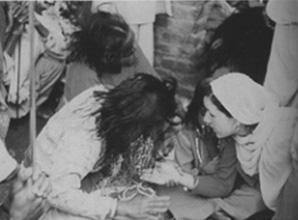

The Goddess Tradition presents various practices and mediums to either invoke a person's own healing energy or to request healing from the Goddess herself. Some practices call for particular goddesses such as the Bodhisattva of Compassion, other wise known as Kwan Yin [song] , or the Goddess Tara [picture] , while other forms, Wicca for example, invoke the Goddess within ourselves [see Self-Blessing Ritual]. Each ritual is specialized according to its own culture and tradition.
For example, Hindus have all night pujas (worship) where the Goddess manifests herself in other women through possession [see Jargata]. Others celebrate the Goddess in the wilderness by honoring a full moon. Additionally, some individuals have used the Goddess as a source of empowerment for personal strength, healing others, or requesting advice on certain matters. The Goddess is also manifested in the arts where people may sing about her [example in contemporary music], write poems to her [personal poetry], paint her [examples], or sculpt her.
I would like to suggest that the Goddess aids her devotees when they are in need through these many forms that she has to offer. Whether one is painting a portrait of her or spending a night chanting with others, I believe the Goddess manifests herself in all these different forms as her skillful means. In other words, there are various practices to choose from which accommodates different needs. My personal belief is that there is not one religious path that dominates any other, but that each one represents a differing seed in our universe and anyone chosen with faith and good intention can be a reliable source of strength. However, I would like to further present some various ways that people over the world call on the Goddess for her strength and healing abilities.
Today the Goddess is widely recognized for the empowerment that she gives to women. Living in a patriarchal society, women are constantly bombarded by images and feelings that they are subordinate to men. Most religions, for example, adheres to this gross reasoning through the worship of male figures such as Jesus, the Buddha, and the stereotypical conception that God is a male divinity. (Christ 247-276) For an innumerable amount of years the female gender has lived with countless amount of disadvantages and struggles due to this power struggle. However, ancestors from our past and spiritual leaders today are guiding females out of this battle and the Goddess tradition has been one of the ways that women are able to regain their courage and strength. Through rituals, gatherings, art, and music women are both able to worship the Goddess and use these vehicles to express her reemergence into this world.
Mayumi Oda, a Japanese-born woman, artist, and Zen practitioner, displays her need for female divinities through mediums such as silkscreen print and acrylic paint. Oda preforms this by changing masculine gods into their female counterparts. (Gadon 249)

| Furthermore, she takes Goddesses and paints them naked with full breasts and buttocks. (I assume this is to suggest a more accurate portrayal of the female body.) Her painting of Kwannon (the Japanese form of Kuan Yin) becomes a symbol for the healing Goddess as she entitles her silkscreen print, "Goddess Hears People's Needs and Comes." (Gadon 250) |
Oda has also been painting the wrathful Tibetan dakhinis as a more applicable expression of women's anger towards our unjust society. (Gadon 251) In The Once & Future Goddess , Elinor W. Gadon explains Oda's portrayal of the beneficial energy produced from these dakhinis: "Mayumi articulates what so many women have felt. Their hunger, sometimes a desperate longing, is unbounded for images of strong, powerful, compassionate, but also righteously angry goddesses, models of females creating the universe, creating themselves, birthing a just society"(251). Through Mayumi Oda's art, she has been able to reveal the need for the healing of patriarchy's wounds imprinted in our culture. |  |
Mary Beth Edelson is another artist who's mission is an attempt to secure women in feeling whole again and not alienated from our patriarchal culture vis a vis rituals focusing on the Goddesses' energy. She does this with both public and private rituals in which her aim is to invoke the Goddesses' healing energy. She documents her rituals with her camera and then literally draws over these photographs to highlight the feelings after the ritual. (Gadon 273) One of her pieces is a photograph and drawing of her own body entitled "Woman Rising/Sexual Energies" which was a private Goddess ritual using her own female consciousness. (For more information, read The Once & Future Goddess.)
In an essay from the text Womanspirit Rising , Carol P. Christ furnishes many reasons why women need the Goddess. She quotes a line from Ntosake Shange's Broadway play: "I found God in myself and I loved her fiercely" (273). Christ explains that this simple line is emulated around the world by women who meet in "small groups on full moons, solstices, and equinoxes to celebrate the Goddess as a symbol of life and death" (273). Further, she explains that the need for a Goddess in our culture is critical because our psyches have been forever bombarded with the male God from Christianity and Judaism. These religious male figures have not left any room for a feminine divinity which has created the embedded view in women's' minds that "female power can never be fully legitimate" (275). Christ also adds that another important implication of the Goddess is the power and energy created in Goddess-centered rituals. Moreover, Christ explains that women in these rituals are taught to believe in their power and determination -- that their positive energy is useful and is needed in this world which is faced with constant hardship and destruction.
In this private ritual the woman is honoring her own divinity, the Goddess within herself. I will hopefully describe this powerful ritual, in a succinct fashion, that Budapest has clearly described in her essay. First, take a shower or bath to cleanse yourself. Create an altar to place on the floor with some salt in a container, a chalice containing half water and half wine, two candles on each side of the altar, and a flower in the middle. The flower in the middle represents your own Goddess spirit in a symbolic form because all that is from the Earth represents the Goddess. Now, take the salt from the altar and place some of it on the floor in front of your altar and stamp on it. Here the salt represents the wisdom (which now you should be standing on), the water represents the life force, and the wine is the sacred delight of the Goddess.
Next, light the two candles and say, "Blessed be, thou creature of fire" (Budapest 270). Then light your incense. Budapest claims that making your own incense, using flower petals, is more powerful than store bought (personally I do not have instructions on how to make your own incense).
Now you will begin to touch certain parts of your body with the mix of water and wine from your chalice and recite the affirmations that Budapest has given in her essay. First, dip your fingers and touching your forehead, say, "Bless me, Mother, for I am your child" (270). This is an acknowledgement of the birth of your life-force. Dip your fingers again and touch your nose saying, "Bless my nose to smell your essence" (270). This symbolizes that the Goddess dwells in nature, she is nature, and we must remember to smell her through nature (such as the flower before you). Dip your fingers again and touch your lips citing, "Bless my lips to speak of you" (270). Touching your lips is a reminder which respects the powerfulness of speech that the Goddess has given you. Through words we are able to heal others, confess our deepest thoughts, and influence others perhaps inducing change. Again, dip your fingers, touch your breasts, and say, "Bless my breasts, formed in strength and beauty" (270). Now, in acknowledging your connection with all that is female, dip your fingers and touch your genitals exclaiming, "Bless my genitals that bring forth life as you have brought forth the universe" (271). Lastly, dip your fingers and touch your feet saying, "Bless my feet, to walk in your paths" (271). Here you are affirming your power and the divine within you. After finishing this spell, stay on the salt for a few minutes and witness the energy flowing within your body. Extinguish your candles and repeat, "Thank you spirits, for being with me" (271).

The Jagrata, which dates back several hundred years, is an all-night vigil conducted by the devotees of the Goddess as an invitation to invoke the Goddess to visit them in their houses or communities. The ritual is usually preformed to ask for some favor from the Goddess or as reimbursement from her past generosity. The Goddess visits in the form of a flame which is lit at the beginning of the ceremony and kept burning the entire night. In order to be an official jagrata, it must last all night, have a jot (the flame), and end with "The Story of Queen Tara." Two types of jagratas can be held: one held by a family/individual for a small audience or one by an organization for the general public. Usually a family will hold this ritual in honor of a marriage, a birth, or a recovery from a serious illness. The much larger scaled jagrata for the public is usually an annual affair to invoke the Goddess's blessings. Each jagrata has a mandali which is a group that preforms the rituals, sings the songs, and tells the stories. The mandali is the middleman between the Goddess (or Devi in Sanscrit) and the sponsor of the event. Erndl, in Victory to the Mother , explains it well when she asserts that the meaning of the jagrata is "to keep Devi awake, that is, accessible, approachable, and active in the lives of human beings" (102). (Also, see her book for detailed information on this subject.)
Possession often occurs at jagratas as well as in other contexts. The Goddess often uses the human body, usually a female, as a vehicle in which she can physically manifest herself to her devotees. Possession is characterized by glazing eyes, exuberant dancing, and rhythmic circle head movements of the person that Devi is bearing at that particular time. The Goddess will usually enter a woman's body that is pure, meaning one who is celibate and does not eat meat or drink alcohol. This is a reason why many possessions often take place in young girls. Possession is said to be a way that the Goddess can aid her devotees using a visible and accessible manifestation. (128) Often people will ask the person being possessed for advice on any matter and will bring her offerings such as flowers or incense. Women who are possessed frequently will often become objects of divine worship. This experience may carry over into her normal life where she may become a "religious specialist" (113). The basic view concerning possession is that it is the Goddess who controls this process; this is her manifestation into the human realm.
